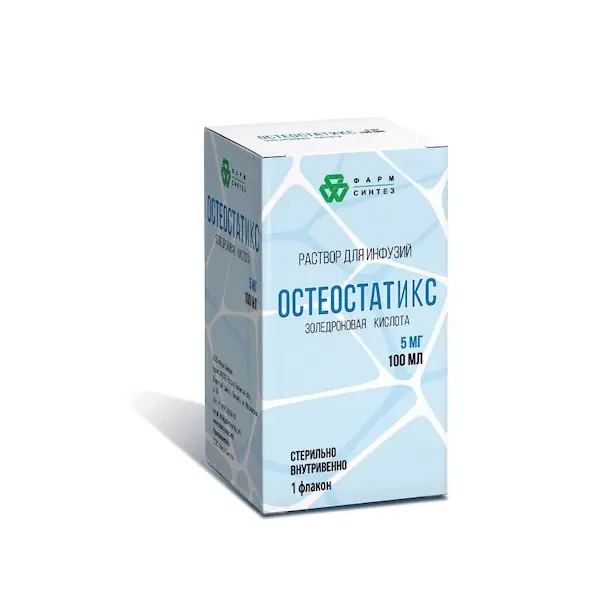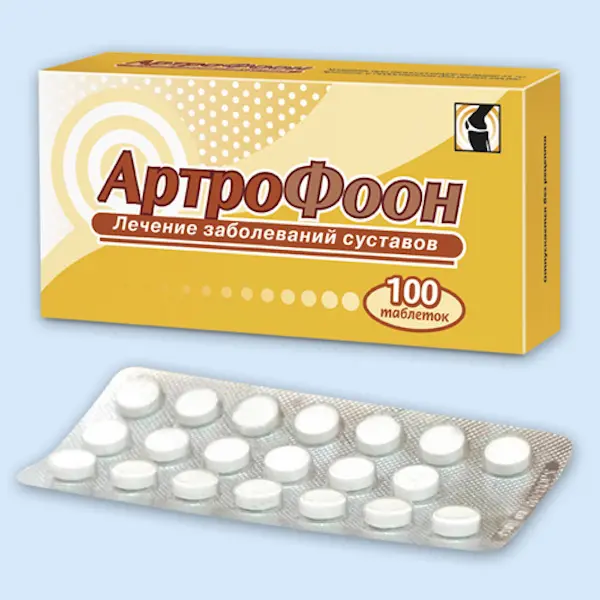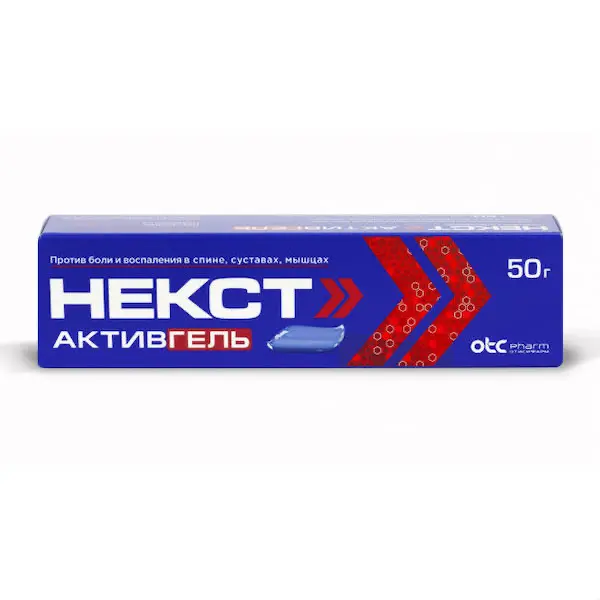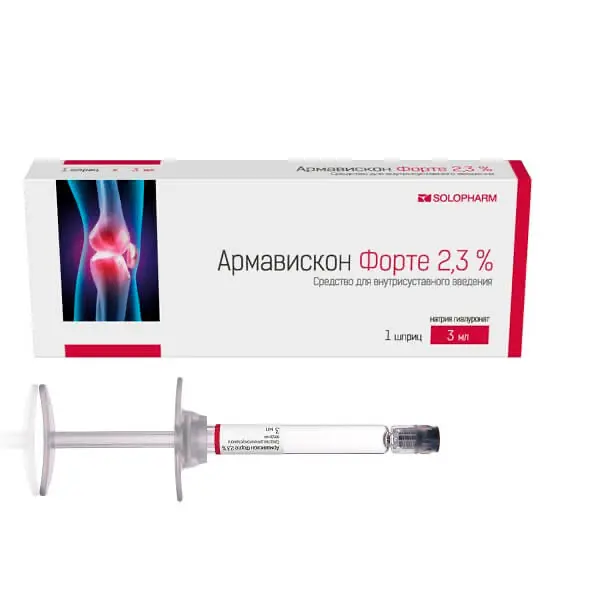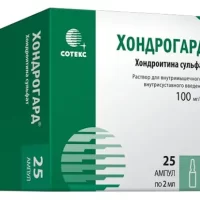Description
Osteostatics Pharmacodynamics
Zoledronic acid, a representative of the class of nitrogenous bisphosphonates, acts mainly on bone tissue, inhibits osteoclast activity and bone tissue resorption.
Selective action of bisphosphonates on bone tissue is based on the high affinity for mineralized bone tissue. After intravenous administration zoledronic acid is quickly redistributed in the bone tissue and, like other bisphosphonates, is localized mainly in the sites of bone tissue remodeling. The main molecular target of zoledronic acid in the osteoclast is the enzyme farnesyl pyrophosphate synthetase (FPS); however, other mechanisms of action of the drug are not excluded. The long period of action of the drug is determined by the high affinity to the active center of FPS and a pronounced affinity to the mineralized bone tissue.
Against the background of using zoledronic acid, a rapid decrease of bone metabolism indices is observed from the elevated postmenopausal values to the minimum acceptable level (by the 7th day for bone resorption indices and by the 12th week for bone formation indices). Subsequently, the indices of bone metabolism stabilize within the limits of premenopausal values.
Experimental models of accelerated osteoresorption during long-term treatment with zoledronic acid have shown that zoledronic acid significantly inhibits bone resorption without undesirable effects on bone formation, mineralization and mechanical properties, dose-dependently reduces osteoclast activity and activation rate of new remodeling foci in both trabecular (cancellous) and cortical (compact) bone tissue, without causing fibrous bone formation and aberrant osteoid accumulation as well as bone mineralization defects. Except for the high antiresorptive effect, the effect of zoledronic acid on bone tissue is similar to that of other bisphosphonates.
Treatment with zoledronic acid reduced the relative risk of femoral fractures by 40% by the 3rd year of therapy. Treatment with zoledronic acid reduced the relative risk of any clinical fractures, nonvertebral fractures of any localization (excluding fractures of the phalanges of the fingers and facial bones of the skull) by 33% and 25% respectively. Administration of the drug for 3 years in patients with postmenopausal osteoporosis showed increases in the bone mineral density (BMD) of the lumbar vertebrae, thigh bone in general, in the femoral neck region and the distal radial bone by 6.9%, 6%, 5% and 3.2% on the average respectively.
Indications
– Postmenopausal osteoporosis (to reduce the risk of femoral, vertebral and extravertebral fractures, to increase bone mineral density);
– Prevention of subsequent (new) osteoporotic fractures in men and women with fractures of the proximal femur;
– Osteoporosis in men;
– Prevention and treatment of glucocorticosteroid-induced osteoporosis;
– Prevention of postmenopausal osteoporosis (in patients with osteopenia);
– Paget’s bone disease.
Contraindications
– Hypersensitivity to zoledronic acid or any other component of the drug or any bisphosphonates;
– Severe disorders of mineral metabolism, including hypocalcemia;
– Pregnancy, breastfeeding;
– Under 18 years of age (because the safety and effectiveness of Osteostatics in this category of patients (children and adolescents) has not been studied);
– severe renal impairment (creatinine clearance ˂ 35 ml/min).
Dosage and administration regimen
- The drug Osteostatix, solution for infusion, is administered intravenously by infusion. The drug should be administered using a valve infusion system ensuring a constant infusion rate for at least 15 min.
- Before administering Osteostatics the patient should be adequately hydrated. This is especially important for elderly patients (≥65 years), as well as for patients receiving diuretic therapy.
- For treatment of postmenopausal osteoporosis in women and osteoporosis in men, the recommended dose of Osteostatics is 5 mg (the content of one vial of the drug is 100 ml of solution) intravenously once a year. In case of insufficient intake of calcium and vitamin D with food, calcium and vitamin D preparations should be used additionally.
- For prevention of further fractures in patients with proximal femur fractures the recommended dose of Osteostatics preparation is 5 mg (the content of one bottle of the preparation – 100 ml of solution) intravenously once a year. Patients with recent (up to 90 days) fracture of the proximal femur are recommended to take a single high dose of vitamin D (50000-125000 IU or intramuscularly) two weeks before the first infusion of Osteostatics. During a single use of Osteostatics patients are recommended to take calcium (1000 mg per day) and vitamin D (800 IU per day) daily for 14 days before infusion. After infusion of Osteostatics, patients should also take calcium preparations and vitamin D for a year.
- To prevent subsequent fractures in patients with fractures of the proximal femur, the first infusion of the drug should be carried out 2 or more weeks after surgery.
- For treatment of osteoporosis caused by glucocorticosteroid use, the recommended dose of Osteostatics is 5 mg (the content of one bottle of the preparation is 100 ml of solution) intravenously once a year. In patients with osteoporosis with insufficient intake of calcium and vitamin D with food, calcium and vitamin D preparations should be used additionally.
- For postmenopausal osteoporosis prophylaxis, the recommended dose of Osteostatics is 5 mg (one bottle of the preparation contains 100 ml of solution) intravenously once in 2 years.
- An annual reassessment of fracture risk and assessment of the clinical response to therapy should be performed to decide whether a repeat infusion is necessary.
- Sufficient intake of calcium and vitamin D is very important for the prevention of postmenopausal osteoporosis. In case of their insufficient intake with food, additional intake of calcium and vitamin D preparations is recommended.
- For the treatment of Paget’s bone disease a single intravenous injection of 5 mg of Osteostatics is recommended.
- Paget’s bone disease is characterized by high activity of bone tissue metabolism. Due to rapid onset of the effect concerning bone metabolism after Osteostatics application during the first 10 days after infusion transient hypocalcemia may develop. Sufficient intake of vitamin D should be ensured during the use of Osteostatics. In addition to this, it is strictly recommended to take an adequate dose of calcium (at least 500 mg of elemental calcium twice a day) for at least the first 10 days after Osteostatics administration.
- Re-treatment with Osteostatics in patients with Paget’s Bone Disease
- After a single use of Osteostatix for Paget’s bone disease, patients experienced a prolonged (about 7.7 years on average) remission. Since Paget’s bone disease is a chronic disease, repeated use of the drug is recommended. Repeated use of the drug in Paget’s disease consists of its intravenous administration in a dose of 5 mg after one year or more from the beginning of treatment. The interval between injections of Osteostatics is determined individually on the basis of treatment efficacy and results of alkaline phosphatase concentration determination, which should be carried out every 6-12 months. If there are no clinical signs of worsening of condition, such as bone pain and compression symptoms and/or radiological signs of disease progression, the next infusion of Osteostatics can be carried out not earlier than 12 months after the first one.

